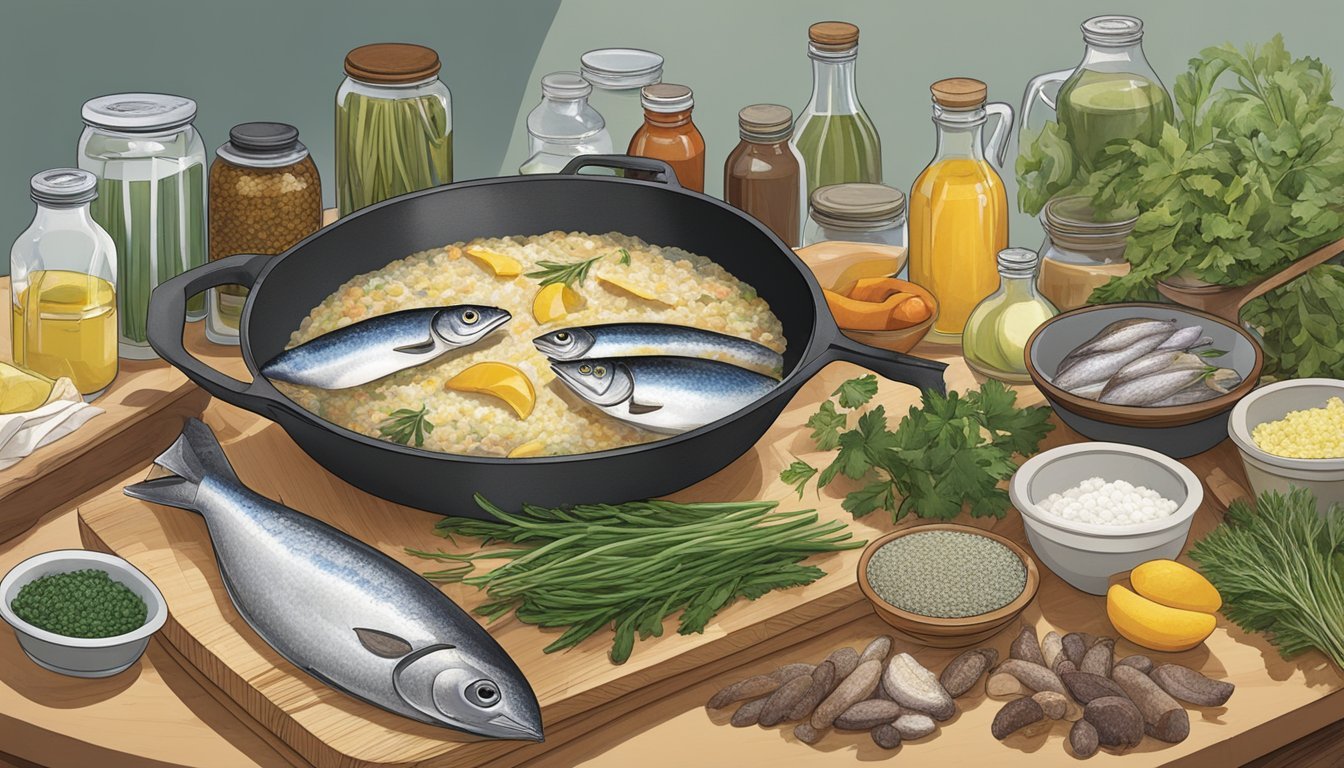Herring Substitutes
Top Alternatives for Recipes
When herring isn't available, sardines and mackerel are excellent substitutes that deliver a similar taste and texture. Both sardines and mackerel share the oily, rich flavor profile of herring, making them ideal for various culinary applications. They also offer comparable health benefits, providing essential omega-3 fatty acids and high-quality protein.
Many people seek herring substitutes due to sustainability concerns. Overfishing has impacted herring populations, prompting consumers to consider more sustainable options. Sardines and mackerel are often more sustainable choices, as they are typically harvested in a way that has less impact on marine ecosystems.
Menhaden is another alternative, though less favored for direct consumption due to its oilier and more robust flavor. Often used in fishmeal and oil, menhaden contributes to marine sustainability by supporting the food chain without being overfished.
Understanding Herring
Herring is a versatile fish known for its rich nutritional profile, diverse culinary uses, and concerns about sustainability. Exploring these aspects can provide better insights into its value and relevance.
Nutritional Profile of Herring
Herring is packed with essential nutrients that contribute to a healthy diet. It is a significant source of omega-3 fatty acids, which are vital for heart health and reducing inflammation. A typical serving can offer approximately 1.5 grams of omega-3 per 100 grams.
This fish is also rich in protein, providing essential amino acids needed for muscle maintenance and repair. Additionally, herring supplies important vitamins and minerals, such as vitamin D, calcium, selenium, and B vitamins. These nutrients support everything from bone health and immune function to cellular metabolism.
Beyond this, herring contains zinc, essential for immune function and enzymatic processes. Its robust nutritional profile makes it a valuable addition to a balanced diet.
Culinary Uses of Herring
Herring serves as a versatile ingredient in many culinary traditions. They can be enjoyed in various forms, including fresh, smoked, canned, and marinated preparations. Each method brings out unique flavors and textures that can be paired with diverse ingredients.
Smoked herring is often used in salads and pâtés, providing a rich, savory taste. Canned herring can be used similarly to sardines, adding a protein boost to sandwiches and crackers. Fresh herring is commonly grilled, baked, or fried, allowing for creative flavor pairings such as mustard and dill.
Herring caviar, also known as roe, is another delicacy, prized for its delicate flavor and texture. This versatility in cooking techniques and flavor pairings makes herring a favored option in both traditional and modern cuisines.
Herring and Sustainability
Sustainability is a critical consideration when it comes to herring, particularly Atlantic herring. Due to overfishing, some herring stocks have been depleted, raising concerns about their long-term availability. Sustainable fishing practices aim to manage and protect these populations.
Consumers should seek out herring that has been certified by sustainability organizations. This ensures that the fish comes from well-managed sources that adhere to guidelines meant to preserve the species.
By choosing sustainably sourced herring, individuals can help reduce the environmental impact and promote the health of marine ecosystems. Sustainable practices are important for maintaining the balance of fish populations and ensuring the availability of herring for future generations.
Popular Herring Substitutes
Herring can be replaced by various other fish and plant-based alternatives depending on the specific dish and flavor and texture desired. Different substitutes ensure you can still enjoy your favorite recipes without sacrificing taste.
Substitutes for Fresh and Smoked Herring
Mackerel: Mackerel is an excellent substitute with a similar oily texture and strong flavor profile.
Sardines: Sardines can mimic the oiliness of herring and are versatile for different cooking methods.
Trout: Fresh and smoked trout offer a delicate flavor and texture comparable to herring.
Butterfish and Bluefish: These options provide a comparable texture and rich taste, suitable for various recipes.
Spanish Mackerel: Its firm texture and rich flavor make it a good alternative.
Salmon and Tuna: These fish work well, particularly in smoked forms, due to their strong, savory profiles.
Substitutes for Herring in Recipes
Mahi Mahi and Halibut: Their mild flavor and firm texture make them suitable for herring recipes.
Tilapia and Catfish: Both offer a neutral flavor and adaptable texture for various dishes.
Swordfish: With its firm texture and ability to hold up in cooking, it’s a reliable substitute.
Sea Bass: Its delicate texture and mild flavor can replace herring in many preparations.
Cod: A versatile choice for its firm flesh and mild flavor that adapts well to a variety of recipes.
Plant-based options: Tofu, banana blossom, and jackfruit are popular for their texture, while seaweed can enhance flavor.
Health Considerations When Replacing Herring
When substituting herring, it's important to consider nutritional aspects such as omega-3 fatty acid content, mercury levels, sodium and fat intake, and special recommendations for pregnant and nursing women.
Balancing Omega-3s and Mercury Levels
Omega-3 fatty acids are crucial for heart health and reducing inflammation. Herring is a rich source of omega-3s, but so are substitutes like salmon, sardines, and mackerel.
Albacore tuna can also be considered, though its higher mercury content requires careful consumption.
For maintaining low mercury levels, opting for smaller forage fish such as sardines might be safer. Regular consumption of these substitutes can sustain the health benefits typically derived from herring, provided they are chosen wisely based on their omega-3 and mercury content.
Choosing Low-Sodium and Low-Fat Options
Many fish, including herring, can come prepared in high-sodium forms such as smoked or salted varieties, posing health risks like hypertension.
Fresh or frozen fish options, as well as those preserved in water rather than oil, can help minimize sodium intake.
By choosing low-sodium alternatives like fresh cod or tilapia, consumers can reduce their risk without sacrificing nutritional value. Additionally, picking fish with lower overall fat content can benefit those managing weight and cardiovascular health.
Recommendations for Pregnant and Nursing Women
Pregnant and nursing women need to be especially cautious about mercury levels in fish to avoid potential harm to fetal and infant brain development. Herring generally has lower mercury content, making it suitable for this group.
Alternatives like sardines and salmon are also considered safe and provide essential nutrients like vitamin D and omega-3 fatty acids.
It's vital to avoid high-mercury fish such as king mackerel and albacore tuna during pregnancy and nursing. Careful selection of fish ensures both mother and child benefit from the nutritional advantages without undue risk.
Preparing and Cooking Fish Substitutes
Proper preparation and cooking techniques are central to achieving the best flavor and texture when using fish substitutes. Key methods include baking, grilling, poaching, and frying, with marinades and sauces adding depth and complexity to the dishes.
Tips for Baking and Grilling
When baking fish substitutes, preheating the oven to 350°F (175°C) is essential. Place the fish substitute on a baking sheet lined with parchment paper to prevent sticking. Lightly brush with olive oil and season with salt, pepper, and dill.
Grilling brings out a smoky flavor that pairs well with fish substitutes. Preheat the grill to medium heat. Coat the fish with olive oil, salt, and pepper. Grilling should be done for 3-5 minutes on each side until the fish flakes easily with a fork.
Making Marinades and Sauces
Marinades enhance the flavor profile of fish substitutes. A basic marinade might include thinly sliced lemon, lemon juice, olive oil, minced garlic, and fresh dill. Allow the fish to marinate for 30 minutes to an hour in the refrigerator.
For added complexity, a mustard and capers sauce can be created. Mix Dijon mustard, capers, olive oil, white wine vinegar, and freshly chopped herbs. This sauce can be drizzled over the cooked fish or used as a marinade before grilling.
Poaching and Frying Techniques
Poaching fish substitutes is a gentle cooking method that maintains moisture. Use a poaching liquid made of white wine, water, lemon slices, and garlic. Simmer the substitutes gently until fully cooked, usually about 5-7 minutes.
Frying provides a crispy exterior while keeping the inside tender. Heat a non-stick pan and melt butter or add olive oil. Fry the fish substitutes for 2-3 minutes on each side. Season with a squeeze of lemon juice and freshly ground pepper for a burst of flavor.
By carefully selecting cooking methods and combining them with aromatic herbs and flavorful marinades, one can achieve delectable results with fish substitutes.
Alternative Flavor Enhancers
Enhancing the flavor of dishes can be achieved through a variety of herbs, spices, and plant-based alternatives. These options provide a diverse range of tastes and can suit different dietary needs.
Using Herbs and Spices
Herbs and spices are effective in boosting flavor without adding extra calories or sodium. Dill and parsley can complement dishes that usually rely on herring. Dill has a slight tangy flavor which works well in marinades and with fish alternatives like sea bass or trout.
Pepper adds a sharp, pungent taste and can be used in various dishes from soups to salads. Garlic and onion powder are other versatile options, enhancing umami richness in plant-based meals. Paprika provides a smoky, sweet edge making it ideal for barbecues and grilled vegetables.
Using these herbs and spices offers flexibility and enhances the natural flavors of the main ingredients, allowing for creative combinations and new flavor pairings in traditional and modern recipes.
Vegan and Plant-Based Alternatives
Vegan and plant-based alternatives provide options for those avoiding seafood. Seaweed and algae are excellent substitutes, offering a briny taste similar to herring. These ingredients also add a nutritional boost, rich in iodine and omega-3 fatty acids.
Avocado can be mashed or sliced, adding creamy texture and healthy fats to dishes. Seeds like chia and flax also bring nutritional value and can be used to thicken sauces or as a topping. Soy sauce and tianmian sauce, a sweet black bean paste, give depth of flavor to stir-fries and marinades.
These alternatives not only match the taste profiles of herring but also provide additional health benefits, making them a practical choice for a variety of dietary preferences.
Storage and Preservation
Proper storage and preservation techniques ensure the quality and longevity of both herring and its substitutes such as mackerel and sardines. These methods vary by the type of fish and the intended duration of storage.
Refrigerating and Freezing Techniques
Fish should be refrigerated immediately if it will be used within a few days.
Fresh herring, mackerel, and sardines should all be stored in the coldest part of the refrigerator, ideally at a temperature just above freezing. Freezing is a practical option for long-term storage. When freezing, use vacuum-sealed bags or airtight containers to prevent freezer burn and moisture loss. The fish should be frozen at its freshest to maintain quality.
For best results, label the packaging with the freezing date. Frozen fish can last up to 6 months if stored properly.
Shelf Life of Substitutes vs Herring
The shelf life of fresh herring is limited compared to canned or preserved substitutes like sardines and mackerel. Fresh herring should be consumed within 2-3 days if refrigerated.
Sardines and mackerel, whether canned or preserved, have a much longer shelf life, often extending up to several years when unopened.
After opening, sardines and other canned fish products should be transferred to airtight containers and consumed within 2 days. Comparing the availability and shelf life, substitutes are more convenient for long-term storage due to their extended shelf stability.
Exploring Caviar Substitutes
When looking for alternatives to traditional caviar, several options offer unique flavors and textures. This guide provides an in-depth look at various substitutes, including their taste profiles and usage tips.
Alternatives to Herring Caviar
Lumpfish Roe: Small, crunchy eggs known for their briny taste. They are often dyed black or red to resemble more expensive caviar and work well as a garnish.
Salmon Caviar (Ikura): Larger, orange eggs with a distinctive pop and a rich, slightly sweet flavor. Often used in sushi, it pairs perfectly with cream cheese and bagels.
Soy Pearls: Created using sodium alginate and soy sauce. These pearls mimic the umami richness of caviar and are encased in algae, offering a unique vegetarian option.
Snail Caviar: Known for its delicate flavor and white to pale pink color. It provides a subtle earthy taste and can be a luxurious addition to gourmet dishes.
Vendace Caviar: A freshwater alternative with small, golden-yellow eggs. It has a milder taste that pairs well with sour cream and blinis.
Tasting Tips for Caviar Substitutes
When tasting caviar substitutes, it's essential to appreciate their unique characteristics.
Pairings: Serve with simple accompaniments like blinis, sour cream, or toast points. Drinks like champagne and vodka enhance the flavor experience.
Texture: Pay attention to the texture. For example, salmon roe's distinct pop differs from lumpfish roe's crunch. Each substitute offers a unique mouthfeel.
Temperature: Serve chilled but not frozen. This maintains the delicate textures and flavors of the caviar substitutes.
Portioning: Use small portions. A little goes a long way, especially with intensely flavored substitutes like snail caviar.
By understanding these tips, one can fully enjoy the diverse range of caviar alternatives available.









